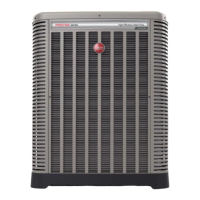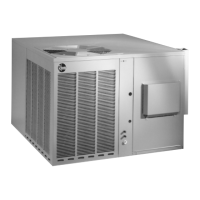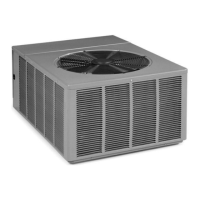11
II. INSTALLATION
A. GENERAL
1. INSTALLATION — Install this unit in
accordance with The American
National Standard Z223.1-latest
edition booklet entitled “National Fuel
Gas Code,” and the requirements or
codes of the local utility or other
authority having jurisdiction.
Additional helpful publications
available from the “National Fire
Protection Association” are: NFPA-
90A - Installation of Air Conditioning
and Ventilating Systems 1985 or
latest edition. NFPA-90B - Warm Air
Heating and Air Conditioning
Systems 1984.
These publications are available
from:
National Fire Protection
Association, Inc.
Batterymarch Park
Quincy, MA 02269
2. PRE-INSTALLATION CHECK-
POINTS — Before attempting any
installation, carefully consider the
following points:
Structural strength of supporting
members
(Rooftop Installation)
Clearances and provision for
servicing
Power supply and wiring
Gas supply and piping
Air duct connections and sizing
Drain facilities and connections
Location for minimum noise and
vibration - away from bedroom
windows
IMPORTANT: Before operating unit,
remove compressor shipping
supports from the compressor base.
Failure to remove supports will casue
noise and vibration.
LOCATION CONSIDERATIONS
The metal parts of this unit may be
subject to rust or deterioration in adverse
environmental conditions. This oxidation
could shorten the equipment’s useful life.
Salt spray, fog or mist in seacoast areas,
sulphur or chlorine from lawn watering
systems, and various chemical
contaminants from industries such as
paper mills and petroleum refineries are
especially corrosive.
3. A liquid cleaner may be used several
times a year to remove matter that will
not wash off with water.
Several different types of protective
coatings are offered in some areas. These
coatings may provide some benefit, but
the effectiveness of such coating materials
cannot be verified by the equipment
manufacturer.
The best protection is frequent
cleaning, maintenance and minimal
exposure to contaminants.
B. OUTSIDE INSTALLATION
THESE UNITS ARE DESIGNED
CERTIFIED FOR OUTDOOR
INSTALLATION ONLY. INSTALLATION
INSIDE ANY PART OF A STRUCTURE
CAN RESULT IN INADEQUATE UNIT
PERFORMANCE AS WELL AS
PROPERTY DAMAGE. INSTALLATION
INSIDE CAN ALSO CAUSE
RECIRCULATION OF FLUE PRODUCTS
INTO THE CONDITIONED SPACE
RESULTING IN PERSONAL INJURY OR
DEATH.
If the unit is to be installed in an area
where contaminants are likely to be a
problem, give special attention to the
equipment location and exposure.
1. Avoid having lawn sprinkler heads
spray directly on the unit cabinet.
2. In coastal areas locate the unit on the
side of the building away from the
waterfront.
3. Shielding by a fence or shrubs may
give some protection.
DISCONNECT ALL POWER TO UNIT
BEFORE STARTING MAINTENANCE.
FAILURE TO DO SO CAN CAUSE
ELECTRICAL SHOCK RESULTING IN
PERSONAL INJURY OR DEATH.
REGULAR MAINTENANCE WILL
REDUCE THE BUILDUP OF
CONTAMINANTS AND HELP TO
PROTECT THE UNIT’S FINISH.
1. Frequent washing of the cabinet, fan
blade and coil with fresh water will
remove most of the salt or other
contaminants that build up on the unit.
2. Regular cleaning and waxing of the
cabinet with an automobile polish will
provide some protection.
!
WARNING
!
WARNING
FIGURE 9. Outside Slab Installation. Closet Distribution System.
Slab Floor Construction
ST-A0886-25

